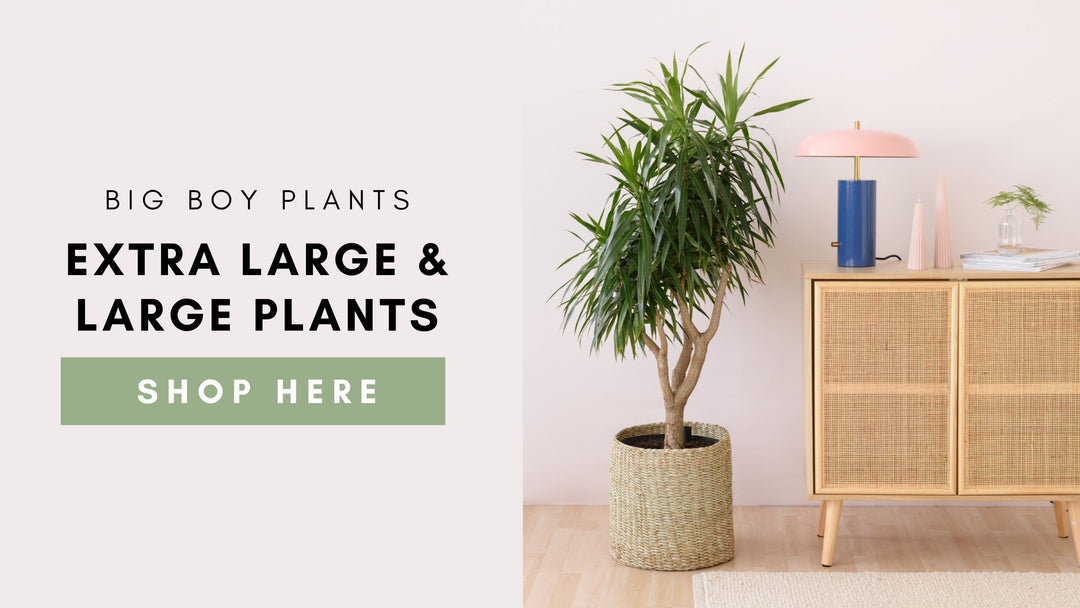Snake Plant Care Instructions
Scientific name: Sansevieria
Synonym: Snake Plant, Mother-in-Law’s Tongue
The Snake Plant is the ultimate popular houseplant for a variety of reasons. From its modern, architectural appeal to its ease of care and impressive air-purifying properties, it truly earns its reputation. Snake Plants tolerate a wide range of conditions, whether indoors or outdoors, and will keep on thriving even when neglected or left in low-light spaces. This makes them a fabulous addition to any beginner’s collection - almost impossible to kill, though not completely immortal.
Over time, with the right care, they may even surprise you with clusters of small, creamy-white flowers on slender stalks. These blooms are rare and sporadic, but when they appear, it feels like a little celebration.

Their leaves are typically deep green, often patterned with lighter horizontal striping or edged with bright yellow margins depending on the variety. Some cultivars even show off striking silver tones, making them all the more eye-catching.
In their natural environment across Africa, Madagascar, and Southern Asia, Snake Plants thrive in dry, rocky soils and withstand long periods without water. This explains their incredible resilience indoors - just as happy in a bright, sunny spot as they are in the shady corners of your home.
Caring for them couldn’t be simpler: water sparingly, provide light without too much harsh sun, and ensure their soil drains well. In fact, they prefer a bit of neglect over too much attention. Independent queens, they’ll happily fend for themselves while you’re travelling or caught up in busy weeks.
Styling is effortless. Pair your Snake Plant with a palm-leaf basket for a Boho-meets-Scandi vibe, or place it in a bold ceramic to complement your décor. Even kept sleek and simple, they shine. Whichever way you style them, Snake Plants remain timeless.
Please note: Snake Plants are poisonous if ingested, so keep away from pets and children.

Snake Plant Common Symptoms
- Yellow leaves and leaves that are soft at their base: This is a sign of overwatering. Be sure to allow the soil to dry out completely before watering again. Wipe off any residual water on the leaves, and avoid it pooling in the rosette or crevices. This can lead to rot.
- Sunken lesions or reddish-brown spots: indicates a fungal infection. Remove affected leaves and treat with a topical, preferably organic, fungicide such as Copper Soap.
- Wrinkled, puckered or curled leaves: usually caused by under-watering or overly dry soil over a long period. Fix this by soaking your plant in water until the soil has become saturated again, and then allow to drain well before replacing it to its position. Adjust your watering regime to check in more regularly.
- Brown, crispy tips: often caused by low humidity, salt buildup in soil or water, or exposure to very cold drafts. If you do not notice a white residue on the soil, then iincrease humidity slightly. If there is a white crystal like residue on the soil, flush soil occasionally with clean water to leach salts, keep plant away from cold windows, AC or heating sources.
-
Leaves becoming floppy, limp or falling over: This often means root rot (usually from overwatering or poor drainage). Check in and ensure your pot is not too big, the more soil you have the more water retention, this leads to slow evaporation and soggy soil. Remedy this by checking roots for rot (brown, mushy, bad smell) remove any dead an mushy roots. Repot in a pot with good drainage, use a loose, well-draining soil mix, cut back watering until plant recovers.
-
Pests: Despite being relatively resilient and rarely having pests, Snake Plants can still fall victim to common houseplant pests. Stress from improper care can make the plant more susceptible to infestations. Watch for mealybugs, scale insects, and spider mites, and Fungus Gnats which can quickly damage the foliage. Signs include discoloured leaves, webbing, or visible insects. Maintain optimal growing conditions and treat any infestations promptly with insecticidal sprays like Pyrol or Neem oil.

Snake Plant Care Instructions
-
Origin: Africa, Madagascar, Southern Asia
-
Height: Up to ~ 100cm
-
Light: Tolerates most light conditions, even low light. Avoid moving from low light directly into very bright sun too quickly (can bleach leaves).
-
Water:
-
Water soil only avoid getting water into the centre “rosette” or on leaves, to prevent rot.
-
In summer, allow the top ~2.5 cm of soil to dry out between waterings.
-
In winter, water sparingly - just enough to prevent total soil dryness. Overwatering is the main cause of death. If unsure, err on the side of under-watering.
-
Water soil only avoid getting water into the centre “rosette” or on leaves, to prevent rot.
-
Humidity: Snake Plants tolerate dry air, though average indoor humidity works well.
-
Temperature: Ideal range is approx 16-24 °C. Avoid extreme cold and drafts (from windows, air conditioners etc.).
-
Soil: Use potting soil that is rich but drains quickly. If necessary, mix in bark or perlite to improve drainage.
-
Fertiliser: Use a balanced general liquid fertiliser at half strength. Feed monthly during spring & summer (active growth).
-
Repotting: Best done in spring. Repot when roots are crowded or plant needs dividing. Keep rosette of leaves at soil level. Use a suitably heavy container, as tall plants can tip over. Make sure to not going larger than 3 to 5cm for you next pot up.
-
Propagation:
- Leaf cuttings: cut a leaf end with a sharp, clean knife; let the cut end dry for a few days; plant “tip-up” about 1 cm into soil.
-
Division: remove plant from pot; use a sharp knife to separate root clusters; replant as needed.
If in stock, shop for Snake Plant here



